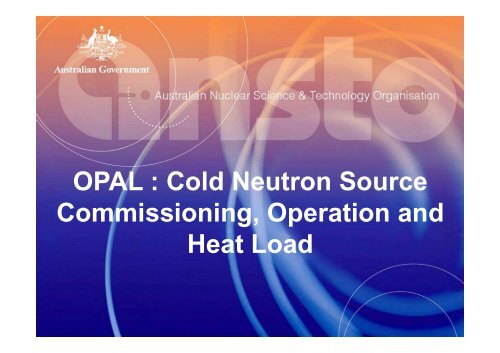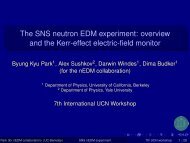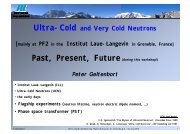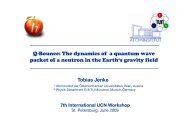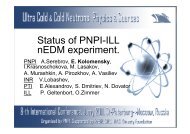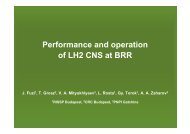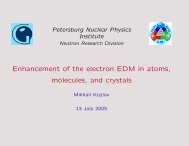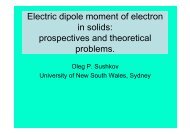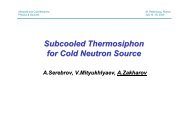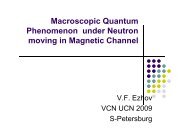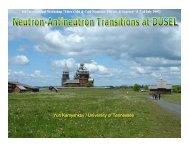OPAL Cold Neutron Source Heat Load Measurement
OPAL Cold Neutron Source Heat Load Measurement
OPAL Cold Neutron Source Heat Load Measurement
- No tags were found...
You also want an ePaper? Increase the reach of your titles
YUMPU automatically turns print PDFs into web optimized ePapers that Google loves.
<strong>OPAL</strong> : <strong>Cold</strong> <strong>Neutron</strong> <strong>Source</strong>Commissioning, Operation and<strong>Heat</strong> <strong>Load</strong>
Outline1. The <strong>OPAL</strong> Reactor and its Utilisation2. CNS Systems.3. Installation and Commissioning 2005-07.4. Operational Issues.5. <strong>Heat</strong> <strong>Load</strong> <strong>Measurement</strong>.
<strong>OPAL</strong> Reactor• 20 MW thermal open pool reactor• Light water cooled and moderated• Plate type compact LEU fuel• Heavy water reflected• Utilisation:– Radiopharmaceutical production– Beam research– Silicon doping
<strong>OPAL</strong> ReactorCRYO-PIPEPRIMARYCOOLANTCNSReactor pool during initial water fillCORE
<strong>Cold</strong> Beams FacilitiesPolarisation AnalysisSpectrometer<strong>Neutron</strong>ReflectometerSmall Angle <strong>Neutron</strong>Scattering Instrument<strong>Cold</strong> Quasi-LaueDiffractometer<strong>Cold</strong> neutron flux of 2.5*E10 n/cm2/s at the reactor face (energyspectrum peak at 2.4meV).
CNS Development Schedule2001 – Project Initiation / DesignThermosiphon prototype testsCNS-RCS factory acceptance testsOn-site testingCNS-RCS integration with in-pileassembly (cryogenic)<strong>Cold</strong> Commissioning commencesLiquefaction of deuterium<strong>OPAL</strong> criticality and then 20 MWHot CommissioningRoutine operationJan 03 Jan 04 Jan 05 Jan 06Jan 07Jan 08
Contractors
Cryo Refrigeration System<strong>Cold</strong> Box(containment)Compressors (2)ReliefHelium piping70mOil SkidCryo Piping
Cryo Refrigeration System
Vacuum & ModeratorSystems
CNS In-pileCNS BeamtubeVacuumcontainmentAlignmentpinCoreHNS Beamtube
Reactor RecoveryForced Evaporation – a transition from NO (cryogenic) modeto SO (warm) mode following system tripTemperature (C) / Flow (g/s)250200150100500He Temp InletHe Temp OutletHe Flow TotalHe Flow to Mod. Ch.He Flow to <strong>Heat</strong> Ex.0 2000 4000 6000 8000 10000 12000Time
Turbine Failure• Turbine failure during transition fromcryogenic conditions.• Inferred cause - air contamination in He.• Air ingress traced to D2 instrumentation.• Instrumentation t ti modified.d
Turbine Failure Investigation• 2 further failures at bearings (’06)• Oil separation efficiency improved• REGEN not performed in July ’07 due toother engineering tests.• Routine sampling discovered d in 500 ppmof N2.• Such N2 identification not typicallypossible (continuous cold operation).
What we knew• Plant entirely pressurised• Some leaks (outgoing) have been found~ 150 L/day• Helium dew point on the high side• N2 contamination not high enough tocause turbine failure(?)
Investigation• Air in-leak verified to be CONTINUOUS• Air in-leak rate measured at ~ max. 0.5L/day under different operatingconditions, e.g. flow rates, compressorstatus, pressure setpoints…• Oxygen/nitrogen ratio variable (analyticalerror).• Large in-leaks previously responsible forturbine damage masked the currentproblem
Turbine Failure Investigation6801. SO - Compressor A only (30 Hz, LP 1.25)N2 Concentr ration (ppm)6305805304804302. SO - Compressor B only3. NO - Compressors A (30 Hz) & B4. SO - Comp A only (repeat, 30 Hz, LP 1.25)y = 3.2384x - 127098y = 11.854x - 466649y = 12.877x - 507127y = 3.7511x - 14730138025/10/2007 4/11/2007 14/11/2007 24/11/2007 4/12/2007 14/12/2007 24/12/2007
Turbine Failure InvestigationCNS-RCS Operating ModeIn-Leakage(ppm /day)Comp A, 30 Hz 3.5Comp A, 30 Hz, 1.5 bar 5.6Comp A, 50 Hz 8.3Comp B, 50 Hz 12Comp B, 50 Hz, 1.4 bar 12NO mode 13Comp A, with CO 2injection intoNo changeshaft seal, ~ 10 ml/minComp A, with He injection intoNo changeshaft seal, ~ 10 ml/minComp A, with He injection into No change (TBC)shaft seal, ~ 100 ml/min
Turbine Failure Investigation
Turbine Failure Investigation• To pin-point leak mechanism- Vacuum test - Tracer gases- Leak tests - Blanketing gasesRun 16 - N2 Contamination Build-up - NO mode, Comp A (50Hz)(16/2 - 17/2 - 2-3000 ml/min He injection comp A, 2-3000ml/min Ar comp B, P_shaft is ~100mmH 2 O;18/2 - 19/2 6-7000ml/min for both He and Ar, P_shaft >150mmH20; 19/2 - 22/2 - no blanket)670.00660.00650.00N2 (ppm)640.00630.00620.00610.00y = 11.628x - 458663600.00590.00y = 6.9447x - 273678580.0015/02/20080:0016/02/20080:0017/02/20080:0018/02/20080:0019/02/20080:0020/02/20080:0021/02/20080:0022/02/20080:0023/02/20080:00
Turbine Failure Investigation• NMR analysis of oil – doublet absent(implying oxidation)Oil separatorCompressor sumpNew oil
Turbine Failure Investigation5• Compressor oil oxidation (acetaldehydeCH3CHO) verified by FT-IR – cause of 2turbine damages in 20064.543.5Comp B (leak detection line)Comp B (used oil)New OilAbsorbance32.521.510.500 500 1000 1500 2000 2500 3000 3500 4000 4500 5000Impurity @1726
1 9 /02 /2 008 0:006 7 0.006 6 0.006 5 0.006 4 0.006 3 0.006 2 0.006 1 0.006 00.005 9 0.005 8 0.005 7 0.00Turbine Failure Investigation380360ntration (ppm)RCS - N2 Conce340320300280Modified Seals (run 21)Original Seals (run 3)Original Seals (run 16)26024028-Mar 30-Mar 1-Apr 3-Apr 5-Apr 7-Apr 9-AprDate
CNS In-pileModerator and Displacer AlMg5 3741 gramModerator D2 19.62 litreNominal D2 Temperature25 KNominal D2 Pressure330 kPa aDisplacer (2.98 l)ModeratorChamber
<strong>Heat</strong> <strong>Load</strong>Measured <strong>Heat</strong> <strong>Load</strong> on the CNS In-pile by Cryogenic Helium Thermal BalanceLinear fits indicate nuclear heat load (W/MW) by the slope and non-nuclear heat load by the offset (W)3500.00Measured <strong>Heat</strong> Lo oad (W)3000.002500.002000.001500.001000.00500.00Liquid DeuteriumGas DeuteriumLinear (Gas Deuterium)Linear (Liquid Deuterium)y = 180.49x + 387.57R 2 = 0.9999y = 85.666x + 363.1R 2 = 0.99880.000 2 4 6 8 10 12 14 16 18 20Reactor Power (MW)
<strong>Heat</strong> <strong>Load</strong>ElementDesignconservative heatload (W)Non-nuclear <strong>Heat</strong><strong>Load</strong> (W)Nuclear <strong>Heat</strong> <strong>Load</strong>(W/MW)Total(D2 Liq. 20K)(178.7) 293.1<strong>Heat</strong> <strong>Load</strong>Total(D2 Vap. 35K)D2 only388 363 25(6%)180.5 85.7 94.8(53%)0.023 W/MW/g - for AlMg5 heat load0.030 W/MW/g - for D2 heat load
<strong>Heat</strong> <strong>Load</strong>SizeDesign <strong>Heat</strong> load(2002)Measured(2008)BOCEOCLiquid D 2 19.6 l 1397 1376 1921D 2Cell 1533 g998Displacer 600 g 391Jacket 1537 g 995Metal 2337 2300 2076Thermal rad. 350 350 388Total (lessisotope source)4084 W 4026 W 4385 W(7%)
Moderator TemperatureLD2 <strong>Heat</strong> <strong>Load</strong>Normalised <strong>Heat</strong><strong>Load</strong> (W/MW)Normalised <strong>Heat</strong> <strong>Load</strong> (W/MW)95.0093.0091.0089.0087.0085.0083.0081.0079.0077.00LD2 saturation temperature28.28 K @ 3.4 bar75.000.8825 26 27 28 29 30 31He Outlet Temp. (K)1.101.081.061.041.021.000.980.960.940.920.90Normalisation to SaturationD2 reservior pressure consumed by LD21.15152.71.10Pressure(kPa)Pressure (kPa)142.7132.7122.7112.71.051.000.950.900.850.80Percentage normalised tosaturation102.70.7525 25.5 26 26.5 27 27.5 28 28.5 29 29.5 30 30.5TT-712Helium Outlet Temp (K)
Thermosiphon Temperature40383634D2 Temp up legD2 Temp down legHe Temp inletHe Temp outetTemp (C)3230282624220 3600 7200 10800 14400 18000Time (s)Reactor power - 15 MW. Loss of cooling
Thermosiphon Temperature(He @ 24K, Reactor 1MW, 570 W heating)Deuterium Temperatur re (In-Pile), K343230282624D 2 Temp (warm thermosiphon leg)D 2 Temp (cold thermosiphon leg)0 2000 4000 6000 8000Time (s)
Thermosiphon Temperature27Deuterium tem mperature,K262524232221ToutTin201000 2000 3000 4000 5000 6000Total heat load,W
<strong>Cold</strong> Beams<strong>Heat</strong> <strong>Load</strong>ContractRequirementOperationCG 3Flux at reactorface1.4 E10 n/cm2/s 1.8 E10 n/cm2/sCG 4 1.4 E10 n/cm2/s /s 2.49 E10 n/cm2/s/sFlux at reactorfaceCG 3SpectrumpeakCG 4Spectrumpeak< 4.2 meV 3.05 meV< 4.2 meV 2.35 meV
SpectrumAfter ShutdownountsC1200001000008000060000PLP915 19.5 K (2.6 sub-cooled)PLP944 20.5 K (1.6 sub-cooled)PLP947 21.5 K (0.6 sub-cooled)PLP954 22.5 K (~3 % vapour)PLP981 23.5 K (~20% vapour)400002000000 5 10 15 20Wavelength
Spectrum% Loss co ompared to 19.5 K0.0-5.0-10.0-15.0-20.0-25.0-30.0-35.0Combined LossesTotal Counts5 Å neutrons10 Å neutrons-40.019 20 21 22 23 24CNS Temp (K)Total counts and long wavelengths drop substantially above 21.5 K
CNS CharacteristicsParameterReactor powerModerator typeModerator volumeModerator TemperatureModeratorcirculation / coolingNominal heat removal capacityValue20 MWLiquid Deuterium20 litres~ 23 KBy natural circulation in a subcooledDeuterium Thermosiphon,He cooled.5000 WAverage <strong>Cold</strong> <strong>Neutron</strong> Flux in Cell 7.3 10 13 ·cm-2·sec-1<strong>Cold</strong> <strong>Neutron</strong> Flux at Reactor Face 1.4 10 10 cm-2·sec-1Moderator Cell materialAlMg5 AlloyVC materialZr-Nb AlloyVC design pressure1.6 MPaCommissioning Year 2005
CNS In-pileVacuumcontainmentLiquidD 2circuitHeliumcircuitD 2 Ocircuit
CNS Description1. In-pile Components (also combining a reflector plug)Vacuum containment: Zircadyne (ZrNb2.5%)Moderator chamber: Aluminium (AlMg5)Sub-contracted: PNPI2. Cryogenic Refrigeration SystemHe circuit, Brayton cycle, 19.8K at 5000WSub-contracted: Air Liquide3. Moderator SystemLiquid deuterium, ~ 24K, 20 m 3 , passive4. Vacuum System2 off (redundancy)5. Gas Blanketing SystemHe / N 2
<strong>Heat</strong> <strong>Load</strong>SizeDesign <strong>Heat</strong> load(2001)Measured(2008)Liquid D 2 19.6 l 1357 W 1921 WD 2Cell 1533 g 998 WDisplacer 600 g 391 WJacket 1537 g 995 WMetal 2384 W 2076 WTotal 3741 W 3997
CNS In-Pile CharacteristicsParameter<strong>Heat</strong> load on the Moderator ChamberD2 pressureNominal Value4300 W330 kPaHe T to the Chamber19 KHe T to the HXTotal cooling He flow rateHe pressure after the TSVacuum around the Thermosiphon19 K160 g/s150 kPa1.3·10 -2 Pa
<strong>Heat</strong> <strong>Load</strong>LD2 <strong>Heat</strong> <strong>Load</strong>Normalised <strong>Heat</strong> <strong>Load</strong> (W/MW)95.0093.0091.0089.0087.0085.0083.0081.0079.0077.00LD2 saturation temperature28.28 K @ 3.4 bar1.101.081.061.041.021.000.980.960.940.920.90Normalisation toSaturation75.000.8825 26 27 28 29 30 31He Outlet Temp. (K)
<strong>Heat</strong> <strong>Load</strong>D2 reservior pressure consumed by LD21.15152.71.10Pressure (k kPa)142.7132.7122.7112.71.051.000.950.900.850.80Percentage norm malised tosaturatio n102.70.7525 25.5 26 26.5 27 27.5 28 28.5 29 29.5 30 30.5TT-712
Thermosiphon Temperature2827Deuterium tem mperature,K262524232221T,in MeasuredToutTin2017 18 19 20 21 22 23Helium temperature,K
In-pile Prototype Testing(PNPI)AIM: To prove heat removal by thermosiphonPROTOTYPE: Moderator chamber and thermosiphon. Twoelectric heaters modelled nuclear heating.RESULTS:Operation in normal cryogenic mode with 4300 W heatinput.Operation in warm stand-by mode with 2650 W heat input.
RCS Factory Acceptance Test(Air Liquid)
RCS Factory Acceptance TestTEST PROGRAM – Jan 2004(Air Liquide)CONCLUSIONS• 5.6 kW heat removalcapacity.• Stand-by operation, andtransition between modessuccessful.LESSONS LEARNT• The cryogenic heliumbypass loop• Helium relief tank• Helium contamination
<strong>Cold</strong> CommissioningTransition from SO (warm) mode to NO (cryogenic) mode withsimulated power/ Flow (g/s)Temperature (C)25020015010050He Temp InletHe Temp OutletHe Flow to <strong>Heat</strong> Ex.He Flow to Mod Ch.007:12 08:24 09:36 10:48 12:00Time
Turbine Failure Investigation• Compressor shaft seal modified
Thermosiphon Temperature<strong>Heat</strong> <strong>Load</strong> Prototype tests OperationD2 2170 W 1921 WVessel 2648W 2076 W
Thermosiphon Temperature27Deuterium tem mperature,K262524232221ToutTin201000 2000 3000 4000 5000 6000Total heat load,WMeasured value (corrected)
<strong>OPAL</strong> Reactor FacilityBragg Inst.CNS BeamLineReactor Pool
<strong>OPAL</strong> Reactor Facility
OperationNormal Operating Mode (NO)Stand-by Operating Mode (SO)Halt ModeFast Warm-up – rapid deuterium vapour warmupForced Evaporation – accelerated return toreactor power (reactor poison–out)Helium injection into the vacuum containment


